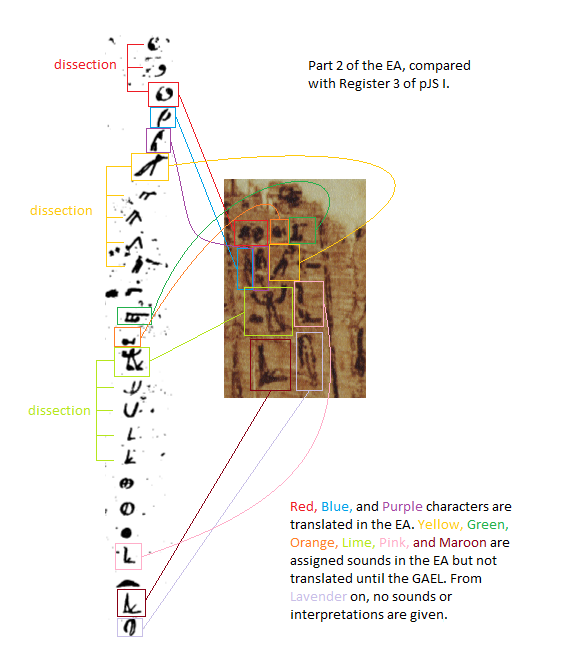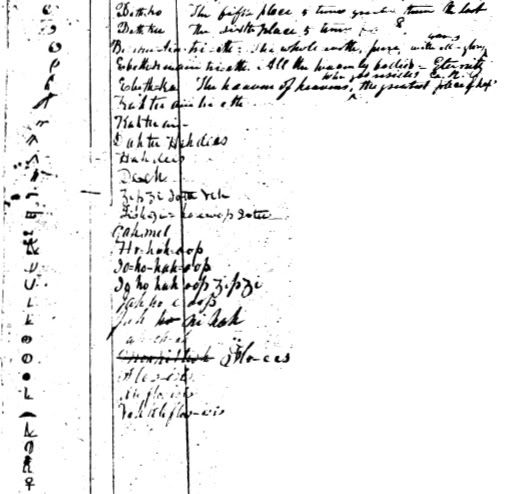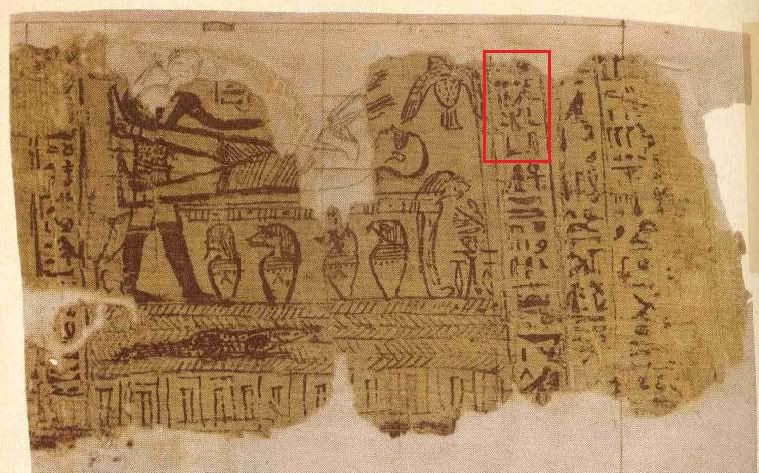Most Frequent Book of Abraham Assertion
-
_Drifting
- _Emeritus
- Posts: 7306
- Joined: Thu Oct 27, 2011 10:52 am
Re: Most Frequent Book of Abraham Assertion
The Book of Mormon was produced without the use of the gold plates.
The Book of Moses was produced without the use of any ancient document.
The JST revision of the Bible was competed without the use of any original documentation.
Why would it be 'new news' that Joseph produced the Book of Abraham without actually using the scroll?
Here's what Will has to say on the matter...
Either way, we see that no one seemed to know where a Book of Abraham text was to be found on the papyri.
Inconveniently the missing papyrus theory doesn't hold water when considering the published facsimiles which can (again inconveniently) be found on the scrolls. So another, different theory, has to be applied - that the facsimiles 'could' mean something different to the translation that every single solitary professional Egyptologist subscribes to.
I would think the Smithsonian and National Geographic would be all over a new reading method of ancient Egyptian. Sadly Will's work on this subject appears to have been discounted out of hand as complete nonsense. I have yet to see professional scholarly support from either of these two (or any other) non religious organisation for Will's as yet unpublished theorising.
Perhaps Will will publish his 'stuff' this time and perhaps it will be taken seriously by the Egyptologist community.
The Book of Moses was produced without the use of any ancient document.
The JST revision of the Bible was competed without the use of any original documentation.
Why would it be 'new news' that Joseph produced the Book of Abraham without actually using the scroll?
Here's what Will has to say on the matter...
Either way, we see that no one seemed to know where a Book of Abraham text was to be found on the papyri.
Inconveniently the missing papyrus theory doesn't hold water when considering the published facsimiles which can (again inconveniently) be found on the scrolls. So another, different theory, has to be applied - that the facsimiles 'could' mean something different to the translation that every single solitary professional Egyptologist subscribes to.
I would think the Smithsonian and National Geographic would be all over a new reading method of ancient Egyptian. Sadly Will's work on this subject appears to have been discounted out of hand as complete nonsense. I have yet to see professional scholarly support from either of these two (or any other) non religious organisation for Will's as yet unpublished theorising.
Perhaps Will will publish his 'stuff' this time and perhaps it will be taken seriously by the Egyptologist community.
“We look to not only the spiritual but also the temporal, and we believe that a person who is impoverished temporally cannot blossom spiritually.”
Keith McMullin - Counsellor in Presiding Bishopric
"One, two, three...let's go shopping!"
Thomas S Monson - Prophet, Seer, Revelator
Keith McMullin - Counsellor in Presiding Bishopric
"One, two, three...let's go shopping!"
Thomas S Monson - Prophet, Seer, Revelator
-
_sock puppet
- _Emeritus
- Posts: 17063
- Joined: Fri Jul 23, 2010 2:52 pm
Re: Most Frequent Book of Abraham Assertion
Perhaps Will Schryver and John Gee could begin a project that would yield the correct, god key to translating ancient Egyptian writings into modern English text, the one that eludes Egyptologists world-wide and causes them to erroneously think that the Facsimiles and the Sensen papyrus read, in English, something other than what JSJr tolds us they say. The first test of the translation key they would produce would've course be that applying it to the Facsimiles, the resulting English text would read as and comport with the Explanations.
Next, it could be applied to the ancient Egyptian characters that appear on the Sensen papyrus. If it produces the English text of what we know as the BoAbr, I would stand in under awe and amazement, and adorn Will's and John's heads with laurel wreaths for such an accomplishment.
But then, I'd also want them to apply this new, god's translation key to other ancient Egyptian writings. If the results are intelligible English narratives, well, then I'd be singing hallelujahs and JSJr's praises.
Will, John, let the project commence! God's speed to you both. Return and report regularly, ya hear?!
Next, it could be applied to the ancient Egyptian characters that appear on the Sensen papyrus. If it produces the English text of what we know as the BoAbr, I would stand in under awe and amazement, and adorn Will's and John's heads with laurel wreaths for such an accomplishment.
But then, I'd also want them to apply this new, god's translation key to other ancient Egyptian writings. If the results are intelligible English narratives, well, then I'd be singing hallelujahs and JSJr's praises.
Will, John, let the project commence! God's speed to you both. Return and report regularly, ya hear?!
-
_CaliforniaKid
- _Emeritus
- Posts: 4247
- Joined: Wed Jan 10, 2007 8:47 am
Re: Most Frequent Book of Abraham Assertion
stemelbow wrote:Is Will correct when he says there are 4 characters of the 69 that have explanations that can be found on the papyri?
I count about eleven, plus a few more that are dissected "parts" of those. Other characters are assigned "sounds" but never interpreted.
For reference, here's a summary of the character derivations in the EA documents:
First Part – A series of characters which seem to be invented. Some of the characters are treated as composites and broken down into component parts.
Second Part – Begins with a series of invented characters, with their “sounds” arranged in something like English alphabetical order, with interpretations given. Several of these characters and interpretations appear to be copied or adapted from the “specimen of some of the ‘Pure Language’”. Then follow the characters from Register 3 of PJS I, with “sounds” given but only the first three interpreted. (About four more are later given interpretations in the GAEL.) A few characters from the papyrus are dissected into component parts, and the parts are apparently reassembled to create more invented characters.
Third Part – Characters from Register 2 of PJS I, with only a couple “sounds” given. (These two are later interpreted in the GAEL.)
Fourth Part – Characters from Register 1 of PJS I, with no sounds or interpretations.
Fifth Part – Characters from Register 4 of PJS I, with no sounds or interpretations, followed by two characters from the beginning of Column 1 of the Hor Book of Breathings (PJS XI), interpreted with sounds given.
If so, what do you make of the other 65 characters with explanations?
Joseph seemingly starts the EA project intending to create a comprehensive lexicon of sub-characters derived from inspiration alone, then changes his plan and begins pulling characters from pJS I. However, the important thing is that he made no clear distinction between these two methods. They blend into each other, and he makes use of both types of entries in translating the Book of Abraham.
It appears Will thinks George's claim that he will demonstrate the other characters to be from the papyri will result in George making some pretty tenuous connections.
If George is right, then he's come up with a very elegant solution. I tend to think he isn't, but that may be just because I'm too attached to my own interpretation of the evidence. George's interpretation is certainly plausible, just not a slam dunk.
Last edited by Guest on Sat Dec 10, 2011 8:56 pm, edited 2 times in total.
-
_stemelbow
- _Emeritus
- Posts: 5872
- Joined: Wed Jan 19, 2011 8:40 pm
Re: Most Frequent Book of Abraham Assertion
CaliforniaKid wrote:I count about eleven, plus a few more that are dissected "parts" of those. Other characters from the papyri are assigned "sounds" but never interpreted.
Well I hate to be all demanding, but do you have any visuals?
For reference, here's a summary of the character derivations in the EA documents:
First Part – A series of characters which seem to be invented. Some of the characters are treated as composites and broken down into component parts.
Second Part – Begins with a series of invented characters, with their “sounds” arranged in something like English alphabetical order, with interpretations given. Several of these characters and interpretations appear to be copied or adapted from the “specimen of some of the ‘Pure Language’”. Then follow the characters from Register 3 of PJS I, with “sounds” given but only the first three interpreted. (About four more are later given interpretations in the GAEL.) A few characters from the papyrus are dissected into component parts, and the parts are apparently reassembled to create more invented characters.
Third Part – Characters from Register 2 of PJS I, with only a couple “sounds” given. (These two are later interpreted in the GAEL.)
Fourth Part – Characters from Register 1 of PJS I, with no sounds or interpretations.
Fifth Part – Characters from Register 4 of PJS I, with no sounds or interpretations, followed by two characters from the beginning of Column 1 of the Hor Book of Breathings (PJS XI), interpreted with sounds given.
So what do you make of Will's idea that the EA documents came after the Book of Abraham translation?
Joseph seemingly starts the EA project intending to create a comprehensive lexicon of sub-characters derived from inspiration alone, then changes his plan and begins pulling characters from pJS I. However, the important thing is that he made no clear distinction between these two methods. They blend into each other, and he makes use of both types of entries in translating the Book of Abraham.
So with all the above as a given, on what grounds do you determine that the characters that are not found on the papyri were used by Joseph to translate the Book of Abraham?
Love ya tons,
Stem
I ain't nuttin'. don't get all worked up on account of me.
Stem
I ain't nuttin'. don't get all worked up on account of me.
-
_CaliforniaKid
- _Emeritus
- Posts: 4247
- Joined: Wed Jan 10, 2007 8:47 am
Re: Most Frequent Book of Abraham Assertion
stemelbow wrote:Well I hate to be all demanding, but do you have any visuals?
Maybe later. I'm over my net allotment for the day already.
So what do you make of Will's idea that the EA documents came after the Book of Abraham translation?
He's wrong.
So with all the above as a given, on what grounds do you determine that the characters that are not found on the papyri were used by Joseph to translate the Book of Abraham?
One can match the characters and interpretations from the EAG up with the characters and interpretations supplied in the Abraham manuscripts to fill the lacuna in the papyrus.
-
_stemelbow
- _Emeritus
- Posts: 5872
- Joined: Wed Jan 19, 2011 8:40 pm
Re: Most Frequent Book of Abraham Assertion
CaliforniaKid wrote:One can match the characters and interpretations from the EAG up with the characters and interpretations supplied in the Abraham manuscripts to fill the lacuna in the papyrus.
Alright. Seeing as your done for the day, I'll hope you come back and help me out. I'm missing something here, I think. When you get a chance can you elaborate for me?
I read your paper months ago and I'll have to go revisit it for some more perspective while I await your reply.
Love ya tons,
Stem
I ain't nuttin'. don't get all worked up on account of me.
Stem
I ain't nuttin'. don't get all worked up on account of me.
-
_CaliforniaKid
- _Emeritus
- Posts: 4247
- Joined: Wed Jan 10, 2007 8:47 am
Re: Most Frequent Book of Abraham Assertion
stemelbow wrote:When you get a chance can you elaborate for me?
Tomorrow maybe.
-
_CaliforniaKid
- _Emeritus
- Posts: 4247
- Joined: Wed Jan 10, 2007 8:47 am
Re: Most Frequent Book of Abraham Assertion
That thread over there reminds me why I stopped posting on this subject. Every time I read a Schryver post I want to cut myself.
-
_Shulem
- _Emeritus
- Posts: 12072
- Joined: Fri Jul 01, 2011 1:48 am
Re: Most Frequent Book of Abraham Assertion
CaliforniaKid wrote:That thread over there reminds me why I stopped posting on this subject. Every time I read a Schryver post I want to cut myself.
Be easy on yourself Chris, you mean well and are doing well.
Myself? I spent so much goddamn time studying that stuff over the years I feel like I wasted half my life. I've since made changes and have persued other interests (mostly gay things) -- smiles.
Poor William, he hasn't yet crashed and burned -- but he will. He used acid and is my kindred brother whom I understand somewhat. He has that certain 70's rebellion and it shows! William will eventually be on our side. Of course, I've been saying that for some time now and my timing has been off -- but he will eventually throw the Book of Abraham right into Joseph Smith's face and walk away. William is an angry soul and he is going to implode and explode. I really think so.
Paul O
THE BOOK OF ABRAHAM FACSIMILE NO. 3
Includes a startling new discovery!
Here Comes The Book of Abraham Part I, II, III
IN THE FORM OF A DOVE
Includes a startling new discovery!
Here Comes The Book of Abraham Part I, II, III
IN THE FORM OF A DOVE
-
_CaliforniaKid
- _Emeritus
- Posts: 4247
- Joined: Wed Jan 10, 2007 8:47 am
Re: Most Frequent Book of Abraham Assertion
stemelbow wrote:Well I hate to be all demanding, but do you have any visuals?
Here is a graphic which demonstrates, if nothing else, how ridiculously complex these documents can be. The EA characters shown here are from EA Part 2b. The characters which precede them, in Parts 1-2a, all seem to be invented. The characters which follow them, in Parts 2c-5, are taken from the papyrus but mostly left uninterpreted. Part 2b, as you can see, represents a kind of transitional section. They here switched methods and began taking characters from the papyrus rather than inventing them, but they also here lost momentum and didn't get much farther in the project. Instead of continuing on and interpreting the rest of the characters, they started working on the more elaborate GAEL notebook to give a fuller treatment of the characters already translated.

For context, here's an image of the EA page:

And here's where they're found on the papyrus:
